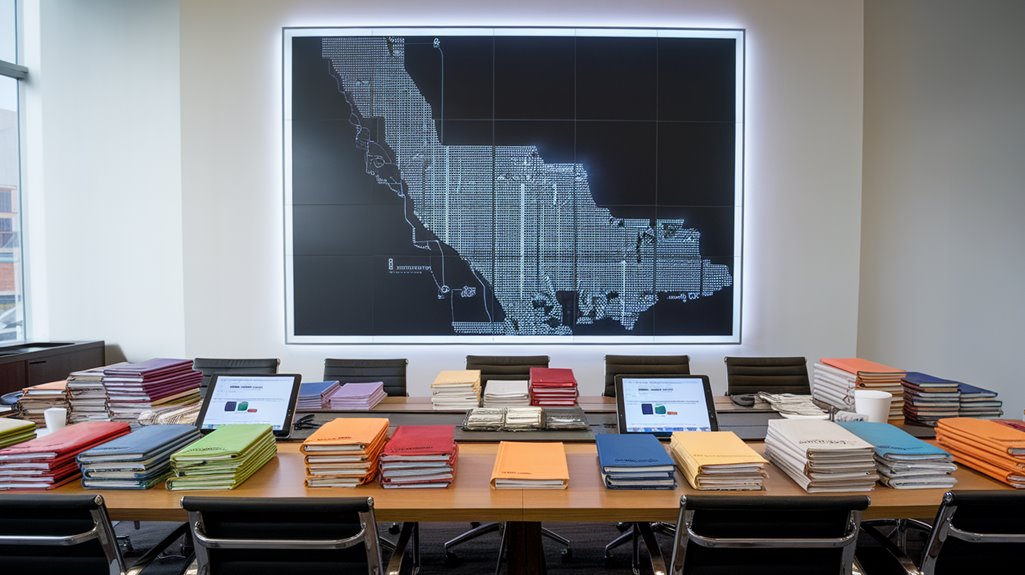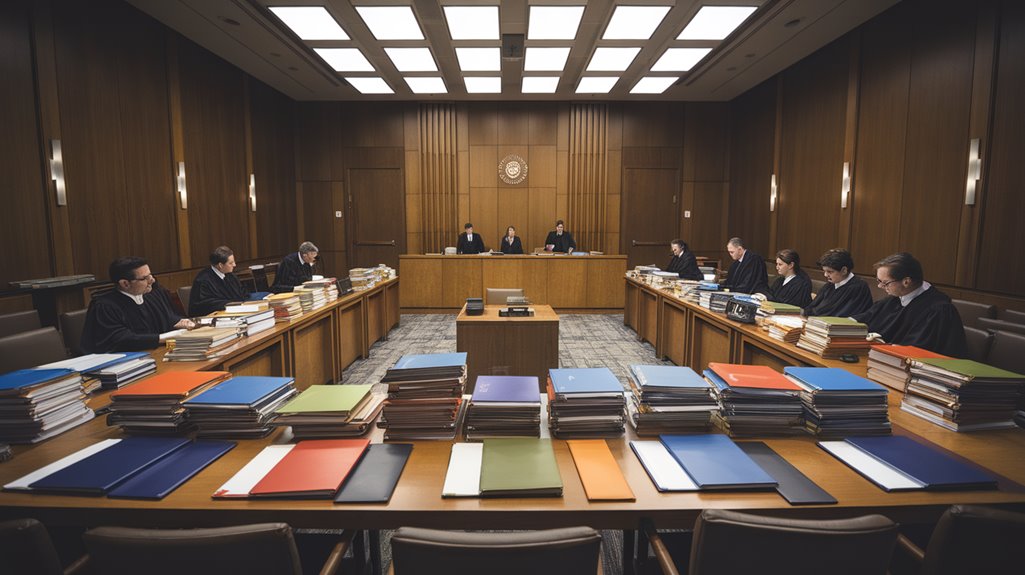Bay Area courts employ multiple strategies to manage complex litigation effectively. Active pretrial case control and streamlined document management systems help process high volumes of evidence. Courts utilize specialized judicial training, mandatory e-filing, and AI-powered tools to reduce backlogs and costs. Early case management conferences and liaison systems enhance coordination in multi-party cases. These proven approaches demonstrate how modern courts can transform overwhelming caseloads into manageable proceedings.
Key Takeaways
- Bay Area courts implement active pretrial control and mandatory e-filing systems to manage over 1,100 complex cases exceeding statutory timelines.
- Employment and wage-hour class actions comprise nearly half of complex litigation in Santa Clara and San Mateo counties.
- AI-driven document review and eDiscovery platforms reduce costs by 67% while streamlining evidence management processes.
- Early case management conferences within 30-60 days of filing establish clear communication channels and structured timelines.
- Lead and liaison counsel systems effectively manage multi-party cases through strategic decisions and administrative coordination.
Current Landscape of Complex Cases in Bay Area Courts

While Bay Area courts have reopened following COVID-19 closures, they face considerable challenges managing complex litigation backlogs. San Francisco struggles with over 1,100 cases exceeding statutory timelines, despite reopening all courtrooms in June 2021. Case backlog reduction varies considerably across counties, with Contra Costa achieving 50% reduction while San Francisco shows limited progress. The current situation is worsened by having only one misdemeanor courtroom operating recently.
Employment and wage-hour class actions dominate complex litigation, representing 48-50% of cases in Santa Clara and 35% in San Mateo. Alameda’s caseload features a mix of asbestos, construction defect, and IP claims. Courtroom utilization differs by jurisdiction, with some counties like San Mateo using alternative venues. Santa Clara handles considerable securities cases, while San Francisco manages mass torts and CEQA disputes. These diverse caseloads challenge efficient court management across the region. Additionally, the evolving nature of litigation has led to an increase in selfdefense claims in the bay area, further complicating the judicial landscape. As attorneys navigate these varied cases, the need for specialized court resources becomes increasingly vital. This growing diversity in litigation types underscores the importance of strategic case management to ensure timely resolutions for all parties involved.
Key Judicial Management Approaches for Complex Litigation

Bay Area courts employ active pretrial case control to manage complex litigation effectively. Streamlined document management systems help judges and legal teams process high volumes of evidence and filings efficiently. Specialized judicial training programs guarantee that judges have the expertise needed to handle intricate legal and procedural challenges in complex cases. The court system strongly encourages parties to minimize evidentiary disputes and organize their cases efficiently to expedite the litigation process.
Active Pretrial Case Control
Nearly all complex litigation cases in the Bay Area benefit from active pretrial case control measures. A significant financial incentive exists, as prolonged cases increase expenses substantially for all parties involved. Effective pretrial strategies focus on early settlement negotiations since 98% of lawsuits settle before trial. Judges actively monitor cases and encourage structured discussions to evaluate settlement possibilities. Case management plans help streamline discovery and reduce unnecessary trial preparation. These measures not only expedite the litigation process but also contribute to a more efficient allocation of judicial resources, allowing courts to handle cases more effectively. Implementing effective pretrial defense strategies can further enhance the likelihood of favorable outcomes for all parties, as they focus on identifying strengths and weaknesses early in the litigation process. As a result, attorneys can craft tailored approaches that align with their clients’ objectives, ultimately facilitating quicker resolutions and minimizing associated costs.
Key elements of active pretrial control include:
- Mandatory e-filing systems for enhanced transparency
- Early case management conferences with judicial oversight
- Test cases to simplify discovery in multi-party actions
- Structured timelines for motion filings and evidence preservation
- Metadata protocols for efficient electronic data organization
These measures have proven successful, with pilot programs showing 43% faster resolution rates and an 18% reduction in case volumes through active judicial intervention.
Streamlined Document Management Systems
Modern document management systems have transformed complex litigation in the Bay Area courts. Unified platforms now combine document retention capabilities with advanced eDiscovery tools, reducing manual processes and human error. Real-time collaboration guarantees all case-related data resides in a single repository.
The integration of AI-driven tools has revolutionized metadata management, with automated categorization and predictive analytics identifying high-risk documents early in the review process. These systems achieve 67% cost reductions in repetitive tasks while handling the growing volume of electronic evidence. Automated redaction support strengthens data privacy compliance, while OCR technology delivers 95% accuracy in document indexing. This streamlined approach has proven particularly effective in complex cases involving multiple parties, where traditional document management methods often fall short. The implementation of version control tracking ensures document integrity and maintains a comprehensive history of all modifications throughout the litigation process.
Specialized Judicial Training Focus
Effective judicial management of complex litigation requires specialized training and focused case oversight. Judges in complex litigation programs receive dedicated instruction in business and commercial law. The Center for Judicial Education and Research provides ongoing education to build judicial expertise. The training curriculum emphasizes early issue evaluation for comprehensive case management outcomes.
- Reduced caseloads allow intensive monitoring of complex cases
- Judges follow guidelines from the Judicial Council's Complex Civil Litigation Deskbook
- Early case management conferences set clear discovery timelines
- Direct judicial mediation resolves discovery disputes within 14 days
- Performance evaluation focuses on case management engagement
Specialized training enables judges to handle technical issues efficiently. They can better manage discovery phases, resolve disputes quickly, and oversee settlement negotiations. This focused approach leads to faster case resolution and more effective outcomes in complex litigation matters.
Essential Elements of Effective Case Coordination

Successful case coordination in Bay Area litigation requires establishing clear communication channels from the outset of proceedings. Multi-party liaison systems help streamline information flow between counsel, courts, and stakeholders while reducing duplicate efforts. Document management solutions enable efficient sharing, tracking, and organization of case materials across all involved parties. In-house and external counsel collaboration strengthens overall case management through shared expertise and resources.
Early Communication Protocols
The Bay Area courts have established clear communication protocols to manage complex litigation from the outset. Effective communication begins with mandatory initial case management conferences scheduled within 30-60 days after filing. Proactive engagement through bilateral meetings between counsel guarantees streamlined discovery planning and dispute resolution. The high stakes nature of these cases demands meticulous attention to communication procedures given the significant financial and reputational implications involved.
- Counsel must meet before first conference to outline discovery plans
- Joint submissions required prior to conferences, including agendas and timelines
- Courts mandate regular status updates on e-Discovery protocols
- RealTime transcripts enable immediate case tracking
- Quarterly case management reviews allow timeline adjustments
These protocols establish a foundation for transparent communication channels between parties and the court. This structure helps identify potential issues early and maintains consistent dialogue throughout the litigation process.
Multi-Party Liaison Systems
Multi-party litigation in the Bay Area requires coordinated liaison systems to manage complex cases. These systems rely on designated lead and liaison counsel who handle specific responsibilities to guarantee smooth case progression. Lead counsel focuses on strategic decisions and unified court positions, while liaison counsel manages day-to-day administrative tasks. The rise of collective action regimes has made these liaison systems increasingly important for managing group litigation effectively.
The success of multi-party dynamics depends on clear communication channels and organized document repositories. Liaison effectiveness improves through specialized teams with local expertise and technology integration. Courts may establish structured frameworks to balance party autonomy with procedural efficiency. This approach enables streamlined case management through centralized hubs, joint defense agreements, and coordinated discovery protocols. The system particularly benefits from liaison counsel's role in facilitating administrative coordination and maintaining consistent communication among all parties.
Document Management Solutions
Modern document management solutions form the backbone of effective Bay Area litigation coordination. Advanced systems streamline document indexing through OCR technology and metadata tagging, enabling precise search capabilities. These tools support efficient case management while reducing review costs by up to 35%. Sophisticated platforms provide panoramic case views that enhance litigation strategy development and execution.
- AI-driven search engines with dual-layer metadata tagging minimize false positives and enhance document retrieval
- Customizable taxonomies allow targeted flagging of sensitive information and jurisdictional categorization
- Cloud-based platforms enable real-time collaboration and secure document sharing across teams
- Automated version control systems maintain thorough audit trails of document revisions
- Browser-based viewers support server-side redactions without compromising original files
This integrated approach guarantees seamless document organization, rapid information retrieval, and effective coordination among case teams across multiple jurisdictions.
Streamlining Class Action Procedures and Oversight

Streamlining class action procedures in the Bay Area requires specific administrative protocols and oversight mechanisms. Courts enforce strict reversion protocols and competitive bidding requirements to guarantee class action efficiency. Settlement administrators must provide multiple bids detailing notice methods and payment processes. Modern search technology solutions help teams efficiently analyze vast document collections for key evidence.
Procedural transparency is maintained through standardized opt-out deadlines and direct court submission of objections. Courts mandate 35-day windows for opting out and maintain electronic records of all objections. Cy pres recipients must align with class claims, with full disclosure of counsel relationships to prevent conflicts. Project management tools track document volumes and discovery elements in multi-district litigation. Courts also implement test case strategies and employ discovery referees to expedite resolution. Experienced judges actively mediate cases to balance scientific and fact-finding priorities.
Maximizing Settlement Opportunities in Complex Cases

Complex litigation in the Bay Area demands strategic settlement planning from the outset. Settlement dynamics require precise timing and negotiation techniques aligned with court schedules. Successful resolutions emerge when counsel leverages key evidence and trial readiness. Maintaining a comprehensive litigation timeline enhances settlement negotiations by providing clear documentation of case developments. In this context, attorneys must also be prepared to address the complexities often seen in the Bay Area, including the most unusual property disputes that can arise due to the region’s diverse real estate landscape. By anticipating these unique challenges, legal teams can better craft their strategies and highlight the nuances that may sway negotiations. Taking a proactive approach not only aids in achieving favorable settlements but also fosters stronger relationships with clients who appreciate the thorough attention to detail in their cases.
- Early gathering of high-impact evidence drives transparent risk assessment
- Strategic timing of settlement talks with court deadlines maximizes leverage
- Active judicial management accelerates case resolution
- Discovery referee appointments reduce procedural friction
- Trial preparation signals enhance settlement positions
Effective settlement strategies avoid premature demands and align with post-discovery timing. Court collaboration through case management orders and consolidated venues streamlines complex litigation. Bay Area courts favor this approach, with 98% of cases settling before verdict when parties execute proper timing and evidence management.
Evolving Role of Technology in Case Management

Technological advances have transformed Bay Area litigation case management. Digital transformation enables law firms to streamline document review through eDiscovery platforms and electronic depositories. These tools allow secure access to evidence across multiple locations.
Automated processes now handle routine tasks that once required manual effort. AI-powered document review identifies key evidence using natural language processing. Cloud storage solutions provide immediate access to case files while maintaining security protocols. Client extranets facilitate real-time collaboration between attorneys and stakeholders. Modern firms must implement dedicated litigation systems to maintain competitive advantage in today's fast-paced legal environment. Predictive analytics help lawyers forecast potential outcomes based on historical data. Document workflow tools generate pleadings and track versions automatically. These technological solutions reduce human error while increasing efficiency in complex litigation management.
Best Practices for Multi-Party Litigation Success

Bay Area multi-party litigation demands specific strategies for success. Success hinges on collaborative negotiation and strategic resolutions through careful preparation and coordination. Legal teams must focus on efficient processes that serve multiple stakeholders. The inclusion of co-mediators for groups helps manage complex negotiations more effectively when dealing with numerous parties. In addition, fostering open communication among all parties involved can lead to more innovative solutions and minimize conflicts. This is particularly important when considering sensitive issues, such as domestic partnerships in the Bay Area, which may encompass varying perspectives and legal considerations. By prioritizing transparency and inclusivity, legal teams can pave the way for agreements that address the diverse needs of all stakeholders.
Multi-party litigation requires careful coordination and strategic planning to achieve successful outcomes that benefit all stakeholders.
Key practices for multi-party litigation include:
- Early identification and engagement of all relevant parties including insurers and guarantors
- Implementation of structured document retention protocols across decentralized storage systems
- Utilization of expert mediators for preliminary case evaluation and guided negotiations
- Development of thorough damages matrices with clear methodologies
- Coordination of cross-border disputes under unified mediation frameworks
These approaches help streamline complex cases while maintaining focus on core objectives. Modern technology platforms support these efforts by enabling synchronized timelines and efficient information sharing among numerous parties.
Frequently Asked Questions
How Do Judges Handle Conflicts Between Multiple Competing Class Action Lawsuits?
Judges employ several class action strategies to resolve competing lawsuits efficiently. They often use joint trials or consolidation to merge similar cases. Judicial conflict resolution includes coordinating between courts through co-judges and case management orders. Courts may implement track-and-portal systems to centralize discovery. Judges can also sequence proceedings to handle key issues first. These approaches help prevent conflicting decisions and reduce redundant litigation costs.
What Qualifications Are Required for Liaison Counsel Appointments in Complex Cases?
As the saying goes, "Experience is the best teacher." Liaison counsel qualifications in complex cases require extensive proven expertise. Key requirements include successful MDL experience, knowledge of local rules, and ability to manage large teams. Complex case requirements demand counsel show independent judicial review, proven collaboration skills, and mastery of digital tools. Courts also evaluate conflict-free status, transparency in billing, and track record of efficient case resolution.
How Are Attorney Fees Calculated and Distributed in Multi-District Litigation Cases?
Attorney fee structures in multi-district litigation typically follow the lodestar method. Courts multiply reasonable hours by approved hourly rates. Fee distribution methods involve both percentage-based and hourly calculations. Common benefit fees usually range from 4-6% of settlements. Courts require contemporaneous time records and segregate hours between settlement work and fee disputes. Judges evaluate market rates and attorney experience when determining compensation levels. They monitor for excessive or duplicate billing.
When Should Parties Consider Bifurcating Liability and Damages Phases?
While some view bifurcation as complicating matters, it ironically simplifies complex litigation. Parties should consider bifurcation benefits when liability is a strong defense and witness overlap is minimal. Trial efficiency improves by separating liability from damages phases. This approach works best when emotional factors could unfairly influence liability decisions. Cost savings emerge through reduced expert testimony and streamlined proceedings. Jurisdictional rules may limit options in certain states.
What Remedies Exist When Electronic Evidence Management Systems Experience Technical Failures?
When electronic evidence systems fail, multiple remedies exist. Courts recognize data recovery protocols through backup systems and disaster recovery sites. System redundancy provides protection through mirrored databases and cloud-based storage solutions. Third-party auditors can verify recovered data integrity. Emergency protocols allow for immediate system restoration. Fail-safe defaults prevent unauthorized access during outages. Courts generally accept evidence from properly restored systems when documented recovery procedures are followed.
Conclusion
Complex litigation in the Bay Area requires strategic management and modern solutions. The 2019 PG&E wildfire cases showed how effective coordination can handle thousands of claims efficiently. Courts now use advanced technology, streamlined procedures, and collaborative approaches to resolve multi-party disputes. Success depends on clear communication, organized case management, and flexible settlement options. These tools help courts navigate complicated cases while ensuring fair outcomes for all parties.
